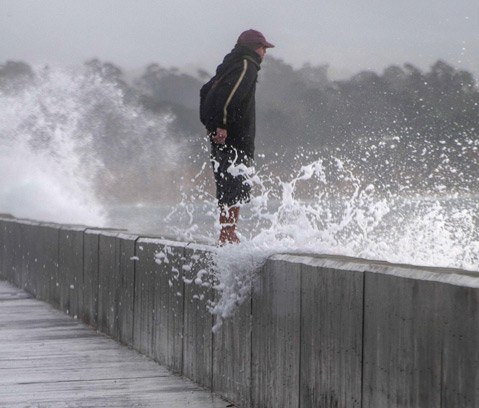Wet ‘n’ Wild While High and Dry
Exploring Slippery Rock and Desal's $42 Million Question

Even with the arrival of this month’s heavy rains — with over an inch dumped at San Marcos Pass in just 10 minutes the night of December 11 — South Coast water agencies continue to gird for the worst.
Flexing most aggressively is the Goleta Water District, which announced last week it had retained a heavy-duty Los Angeles law firm to prevent the Montecito Water District from pursuing a deal with the owners of Goleta’s Slippery Rock Ranch, who boast they have an underground water basin with the same storage capacity as Lake Cachuma. Whether such claims can be backed up has yet to be seen, but John McInnes, general manager of the Goleta Water District, put the Montecito Water District on definite notice there would be no discussion on the matter.
McInnes contends that any pumping of the Slippery Rock basin will suck water from Goleta’s groundwater supply given their close proximity; Montecito, with no groundwater basin to speak of and in a desperate search for supplemental water, had hoped Slippery Rock might provide the buffer it needs. Other South Coast water agencies had hoped from the sidelines that a test well could be pumped over the Slippery Rock basin to determine if its impact on Goleta was as McInnes maintained. If not, Slippery Rock was seen as a possible short-term water option that might buy area water agencies a little more time to develop a long-term response to one of the most ferocious droughts to hit California.
Moving with more genteel force, the Santa Barbara City Council agreed — at least in concept — that it would make sense to prohibit turf irrigation within city limits, barring torrential downpours. Even with a host of exceptions written into the proposed measure, city water planners estimate such a ban could save about 1,100 acre-feet a year, about one-tenth the city’s annual water use. Councilmembers were conditionally open to a ban on new private wells within city limits, though to date such drilling has not emerged as the problem it’s been in Montecito, where just this year, 70 new well-permit applications have been submitted. Likewise, they supported efforts to defer the installation of landscaping in new developments.
Councilmembers were far less interested in banning the construction of new swimming pools — there are about 15 installed a year — or new developments that increase net water consumption. In the past 10 years, such developments have generated 28 acre-feet of new water demand a year. The Entrada project, now under construction at the base of State Street, is slated to add to the demand by 8.25 acre-feet a year. So far, City Hall has relied almost exclusively on voluntary compliance programs, and a shift to a more adversarial regulatory approach is regarded by water planners with some trepidation, particularly where the water savings involved is relatively small.
The $42 million question is whether the planners can accumulate enough water by conservation, additional rainfall, or buying it from Northern California rice farmers that they won’t feel compelled to sign a contract next April to recommission the city’s long-dormant desalination plant. For billing purposes, the cost of recommission is estimated at about $40 million with another $5 million a year to actually produce water.
During a live radio broadcast hosted by KCRW’s Warren Olney, Mayor Helene Schneider found herself pressed gently but persistently to explore options other than desalination. Bob Wilkinson, a professor at UCSB’s Bren School of environmental science, noted that all but one of the many desalination plants built in Australia have since been mothballed because of the cost associated with their operations. He promoted the pursuit of reclaimed water — indelicately dubbed “toilet-to-tap” — instead.
Schneider noted that the city’s water master plan called for desalination as a last-gasp solution in case of a persistent and virulent drought. If it doesn’t rain in appreciable quantities the next year, she said, Santa Barbara will need an emergency water supply the year after. In that scenario, she argued, City Hall would have insufficient time to develop a new water source other than desal and secure the necessary statewide permits.



